Jamini Roy, born in 1887, transformed Indian art by blending folk inspiration with modernism. His vibrant colors and unique techniques set him apart as a master. You'll notice how he uses indigenous materials like lamp black and mineral dyes to create accessible art that resonates with daily life. Iconic pieces like "Mother and Child" and "Ramayana" showcase his ability to capture cultural narratives. Recognized globally, he reshaped modern Indian art, encouraging artists to explore local stories. His influence continues to inspire. If you're curious about his lasting impact, there's more to uncover about his artistic journey and legacy.
Key Takeaways
- Jamini Roy was a pioneer in blending traditional folk art, particularly Kalighat paintings, with modernist techniques to create a unique visual language.
- His artistic style is characterized by a bold color palette, flat perspective, and simplified forms, emphasizing themes of everyday life and folklore.
- Major works include "Mother and Child," "Ramayana," and "Bride and Two Companions," showcasing his mastery in vibrant colors and storytelling.
- Roy's contributions reshaped Indian art, influencing future generations to explore local narratives and materials, making art accessible to the middle class.
- He received the Padma Bhushan in 1955 and is celebrated as one of the Nine Masters of Indian Modern Art, with a lasting cultural impact.
Early Life and Education
Jamini Roy, a pioneering figure in Indian art, was born on April 11, 1887, in Beliatore, Bankura district, West Bengal, to a family that valued creativity.
Growing up in such an environment, you can imagine how his early life was steeped in artistic influence. His upbringing coincided with a time when astrology and beauty standards played a significant role in shaping cultural perceptions in India.
At just 16, he attended the Government College of Art in Kolkata, where he was lucky enough to learn from prominent figures, including Abanindranath Tagore, the vice-principal.
In 1908, Jamini graduated with a Diploma in Fine Art, and his education played an essential role in shaping his artistic vision. He absorbed the ideals of E.B. Havell and Rabindranath Tagore, which ignited his passion for Indian art forms.
During his formative years, you'd see him gravitating toward folk and tribal art. He drew significant inspiration from the vibrant Kalighat paintings he encountered, immersing himself in the rich traditions of Indian culture.
This early exposure to traditional art laid the groundwork for Roy's unique style, allowing him to blend modernism with folk art.
Artistic Style and Techniques
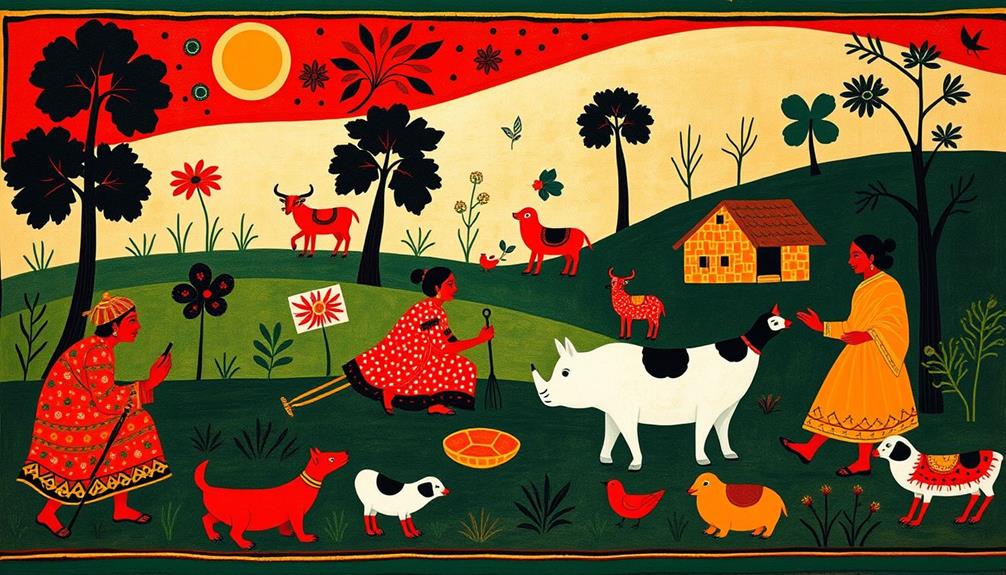
Jamini Roy's artistic style captures your attention with its bold color palette and striking simplicity.
His work resonates with the current trend of contemporary art trends, showcasing a blend of tradition and innovation.
You'll notice how he employs a flat perspective technique that highlights the essence of his subjects while using indigenous materials to achieve a unique texture.
This approach not only reinforces his connection to Bengali folk traditions but also makes his work accessible and engaging.
Bold Color Palette
A bold color palette defines the artistic style of Jamini Roy, making his work instantly recognizable. You'll notice how he brilliantly uses vibrant hues, often derived from indigenous materials like lamp black and mineral dyes. This choice not only showcases his deep connection to traditional art but also elevates the modern Indian aesthetic.
His technique emphasizes color density, allowing the bold colors to dominate each composition, which resonates with the belief that astrology influences attractiveness through the psychological impact of self-perception. This creates a striking visual impact that captures your attention and resonates emotionally. The simplicity of his forms complements the richness of his palette, letting the colors speak volumes about the themes of daily life and folklore.
Roy's pioneering approach revives traditional Indian folk art aesthetics while establishing a unique visual language within the modernist movement. His works invite you to explore the essence of cultural narratives through an engaging interplay of color and form.
Flat Perspective Technique
Emphasizing simplicity and accessibility, Jamini Roy's signature flat perspective technique transformed the way subjects were represented in art. By moving away from Western academic styles, he embraced a method that distilled figures into essential lines and forms. This approach, inspired by Kalighat paintings, created a frieze-like quality that captured the essence of ordinary people and their everyday lives.
Additionally, the cultural relevance found in Aboriginal resources fosters a deeper appreciation of artistic expressions across different communities.
In your exploration of Roy's work, you'll notice how his use of bold colors and flat compositions contributes to a graphic quality that makes his art striking and relatable. The flat perspective technique allows for a clean presentation, which enhances the visual impact of his subjects.
You might appreciate the monochromatic elements he employed, utilizing lamp-black and natural pigments to add depth and structure while maintaining a flat appearance.
Roy's mastery of brushwork shines through in this technique, reflecting not just artistic skill but also a deep connection to cultural narratives. His artworks resonate with the common people, making them accessible and inviting, thereby ensuring that the beauty of Bengali folk art reaches a broader audience.
Indigenous Materials Usage
Building on the foundation of his flat perspective technique, Roy considerably transformed his artistic practice through the use of indigenous materials. He pioneered the incorporation of lamp black, organic tempera, and mineral pigments, which enhanced the vibrant quality of his artworks.
By utilizing woven mats and cloth as mediums, he embraced local textures and techniques that reflected Bengal's rich cultural heritage. This approach parallels the modern farmhouse decor trend of emphasizing natural materials like wood and stone, making art an integral part of the home environment, much like charming farmhouse dining room features.
Roy's distinctive flat technique emphasized bold colors and simple forms, allowing the natural pigments to shine without the distractions of Western artistic conventions. You'll notice how he distilled subjects into essential lines, showcasing his skill in using these materials to create graphic, monochrome works.
This approach not only made his art visually striking but also accessible and relatable to the common people. In doing so, Roy promoted traditional practices within the context of modern art, bridging the gap between the past and present.
This integration of indigenous elements into his work marked a significant contribution to the Bengal School of Art, positioning him as a master of folk-inspired modernism. His legacy continues to inspire artists today, urging them to explore the richness of local materials in their creative expressions.
Major Works and Exhibitions
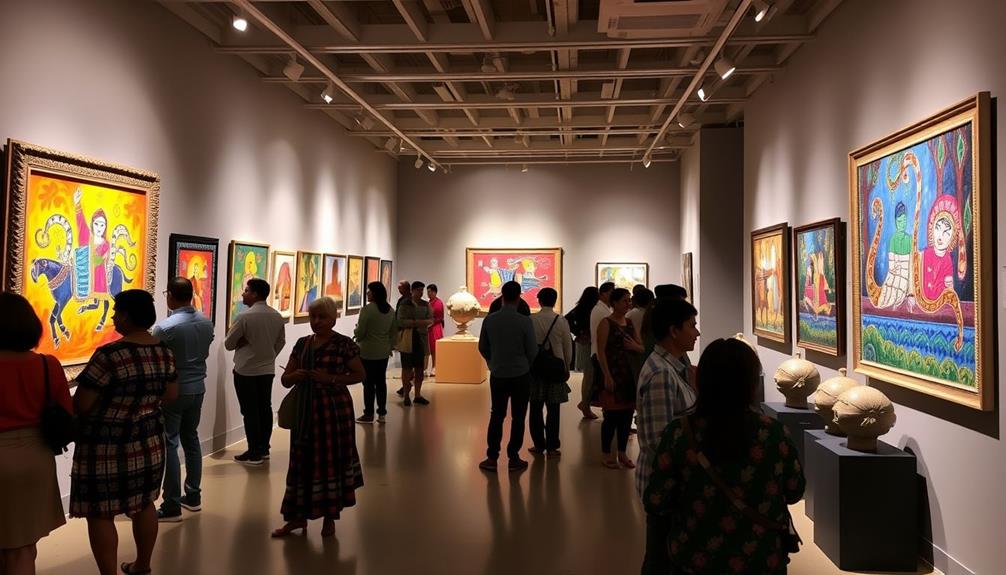
What defines Jamini Roy's impact on modern art? His ability to blend folk aesthetics with contemporary themes sets him apart.
Through his paintings, he captured the essence of Indian culture while embracing a modern outlook. His unique approach resonates with the emotional depth found in many best animated movies that explore heartfelt stories.
Here are some of his major works that exemplify this fusion:
- "Mother and Child" (mid-1920s): An iconic oil painting celebrated for its emotional depth, now housed in the National Gallery of Modern Art.
- "Ramayana" (1946): This magnum opus consists of 17 canvases in the Kalighat pata style, showcasing Roy's mastery of folk art techniques.
- "Bride and Two Companions" (1952): Recognized for its vibrant indigo hues, this work reflects Roy's focus on village life and cultural narratives.
- Global Exhibitions: His artworks have been exhibited in major cities like London and New York, solidifying his international reputation.
Jamini Roy's modern paintings resonate with audiences around the world, and his works are preserved in prestigious institutions, including the largest private collection at the Sarada Charan Das residence in Kolkata.
His legacy continues to inspire and influence contemporary art.
Contributions to Indian Art
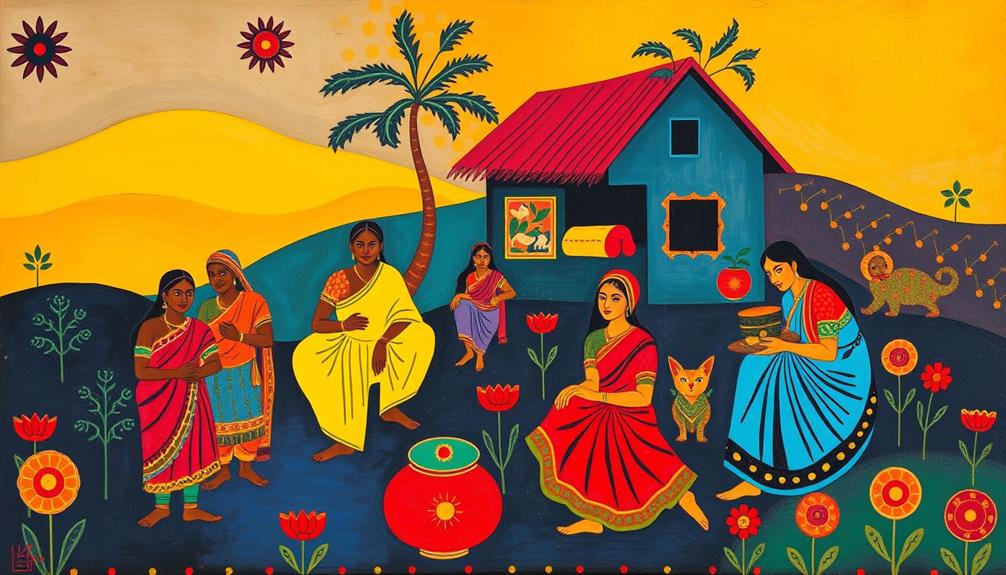
Jamini Roy's influence on Indian art extends far beyond his individual masterpieces; he fundamentally reshaped the landscape of modern art in India. As the first modernist master in Indian art history, he masterfully blended traditional folk art with modernist techniques, creating a unique visual language that resonated with many.
His commitment to diversification of retirement portfolio can be likened to Roy's efforts in diversifying artistic expression, using indigenous materials like natural pigments and organic tempera to revive traditional art forms and promote them within a contemporary context.
Throughout his lifetime, Roy produced around 20,000 paintings, averaging about ten daily, showcasing his dedication to making art accessible to the middle class. His notable works, such as "Mother and Child" and "Ramayana," reflect themes from Indian mythology and rural life, leaving a lasting impact on future generations of artists in India and beyond.
His contributions didn't go unnoticed; he received prestigious accolades, including the Padma Bhushan in 1955 and the Viceroy's Gold Medal in 1934. Through his innovative approach and prolific output, Jamini Roy's paintings continue to inspire and engage, marking a significant chapter in the evolution of Indian art.
Legacy and Recognition
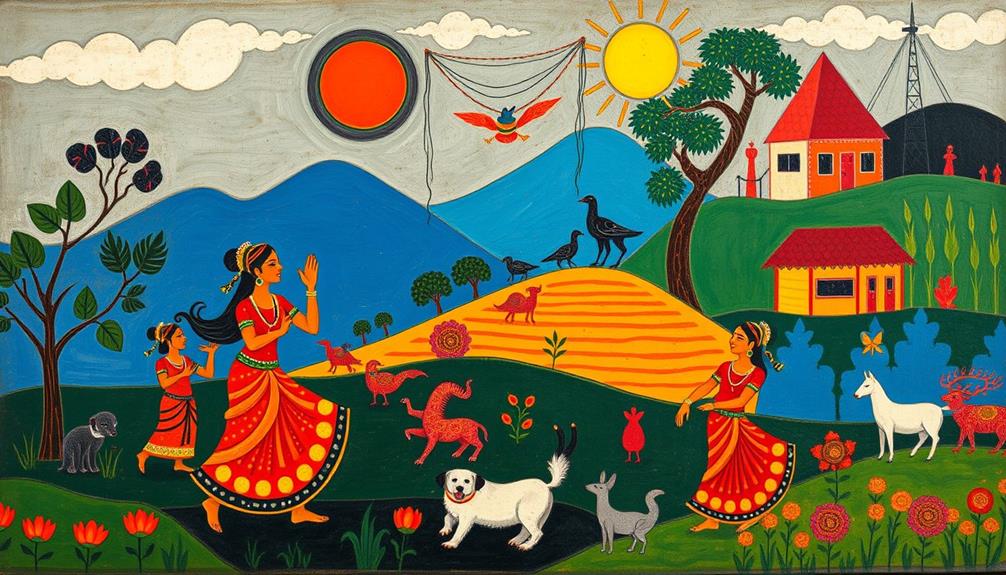
The legacy of Jamini Roy continues to resonate in the art world, celebrated for his innovative fusion of folk traditions and modernism. His contributions haven't only shaped Indian art but have also earned him significant recognition both nationally and internationally.
You can appreciate the depth of his impact through these key points:
- Padma Bhushan: Awarded in 1955, this prestigious honor recognized his transformative role in Indian art. Additionally, his work exemplifies the importance of cultural heritage, much like how understanding safe foods is essential for canine health.
- Cultural Significance: After his death in 1972, Roy's works were deemed national treasures, acknowledged by the Archaeological Survey of India.
- Global Exhibitions: Numerous retrospectives and exhibitions showcase Roy's works, underlining his influence across the global art scene.
- Contemporary Recognition: In 2017, Google India celebrated his 130th birthday with a Doodle, highlighting his enduring impact on modern culture.
Through these milestones, you can see how Jamini Roy's legacy lives on, inspiring new generations and cementing his place among the Nine Masters of Indian Modern Art.
His art remains an essential part of India's cultural heritage, proving that the fusion of tradition and modernity can create timeless masterpieces.
Influence of Kalighat Paintings
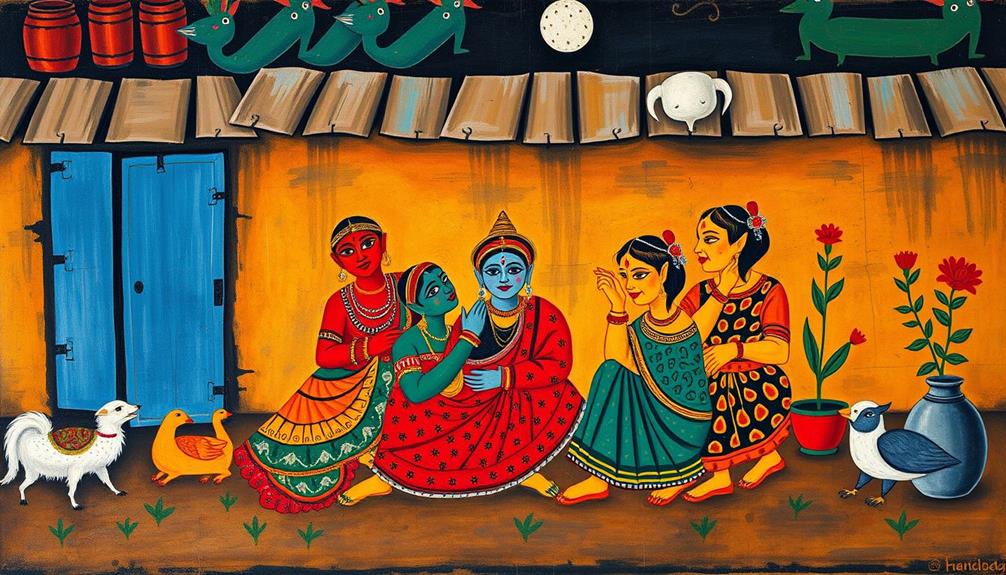
When you explore Kalighat paintings, you'll notice their vibrant colors and bold outlines that define this traditional art form. These characteristics not only bring life to religious and folkloric themes but also reflect the everyday experiences of the people.
The accessibility of learning resources for herbalism parallels the way Jamini Roy made traditional art more relatable and engaging for the modern viewer. Jamini Roy embraced these elements, blending them with his modern interpretations to highlight the cultural significance of this art in contemporary society.
Kalighat Artistic Characteristics
Influenced by the vibrant legacy of Kalighat paintings, many artists have drawn inspiration from their bold colors and narrative styles. These artworks, created by patuas in the 19th century, conveyed powerful stories through their expressive forms.
Jamini Roy stands out as a key figure who embraced Kalighat's artistic characteristics, blending them with modernist techniques. Cats, much like the art of that era, exhibit unique emotional responses that can be as vibrant and varied as the colors in Roy's paintings cat behavior and emotions.
Here are some defining features of Kalighat art that resonate in his work:
- Bold Colors: Kalighat paintings use striking natural pigments that capture attention and evoke emotion.
- Simplified Forms: The reduction of complex shapes into flat, clear outlines makes the art accessible to all.
- Narrative Focus: Kalighat art tells stories, often depicting religious themes and daily life, which Roy adopted in his own creations.
- Cultural Relevance: By incorporating traditional motifs like gopis, Roy guaranteed that his art remained connected to folk art while appealing to contemporary audiences.
Through these artistic characteristics, Jamini Roy successfully bridged the gap between Kalighat's folk art roots and modern artistic expression, leaving a lasting impact on the art world.
Cultural Significance in Art
How do traditional art forms shape contemporary artistic expression? In the case of Jamini Roy, the influence of Kalighat paintings is profound. Originating in the 19th century, Kalighat art, created by village patuas, showcases vibrant colors and scenes of religious and everyday life in Bengal.
Roy embraced these characteristics, incorporating their bold use of natural pigments and distinctive outlines into his unique modernist style. By merging Kalighat elements with his artistic vision, Jamini Roy revitalized interest in indigenous art forms, making them accessible to a wider audience.
His works reflect the themes and narratives present in Kalighat paintings, bridging traditional folk art with modern interpretations. This connection not only honors local heritage but emphasizes the dignity of ordinary life.
Roy's art celebrates everyday subjects, elevating them to a place of significance within the artistic community. In doing so, he invites you to appreciate the cultural richness of Bengal and recognize the beauty in the mundane.
Critical Reception and Analysis
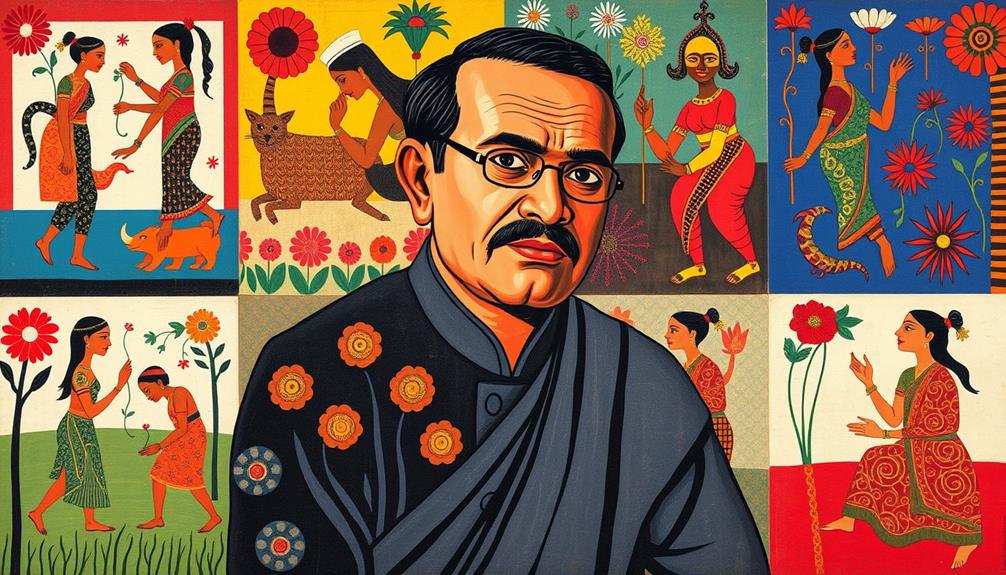
What makes Jamini Roy's art resonate so profoundly with audiences? His unique ability to transform Indian folk traditions into modern expressions plays a significant role. Critics have spotlighted his shift from Western influences, particularly during his 1929 exhibition, marking a pivotal moment in his career.
Here are four key aspects that highlight his critical reception:
- Originality: Jamini Roy distanced himself from revivalist art, instead offering fresh perspectives on Indian culture.
- Accessibility: He made art accessible by bridging the gap between high art and everyday experiences, especially through his depictions of rural life.
- Mastery of Technique: His use of color and brushwork showcased a simplified yet powerful approach, distilling complex themes into relatable forms.
- Cultural Impact: Posthumously, his work is recognized as a national treasure, shaping discussions about the identity of modern Indian art.
Through these elements, Jamini Roy's legacy continues to thrive, and his art remains an essential reference point in understanding the evolution of Indian artistic expression.
You can see how he made art not just for the elite, but for everyone, ensuring its significance endures.
Frequently Asked Questions
What Was the Inspiration of Jamini Roy?
Jamini Roy found inspiration in local Kalighat paintings and the everyday lives of the Santhal community. He embraced vibrant colors, bold outlines, and indigenous materials, reflecting rural culture and mythological narratives that resonated with common experiences.
Which Artist's Work Was Based on Bengal Folk Art?
You're looking for an artist who embraced Bengal folk art in their work. One notable figure is Jamini Roy, who skillfully blended traditional motifs with modern techniques, creating vibrant, accessible art that resonates with many people today.
Conclusion
In celebrating Jamini Roy, you can't help but feel a deep connection to his vibrant folk-inspired modernism. His ability to intertwine traditional motifs with contemporary techniques resonates even today, like a timeless playlist that never goes out of style. Roy's legacy lives on, inspiring countless artists to embrace their roots while forging new paths. As you reflect on his work, you realize that his art isn't just a window to the past; it's a bridge to the future.









